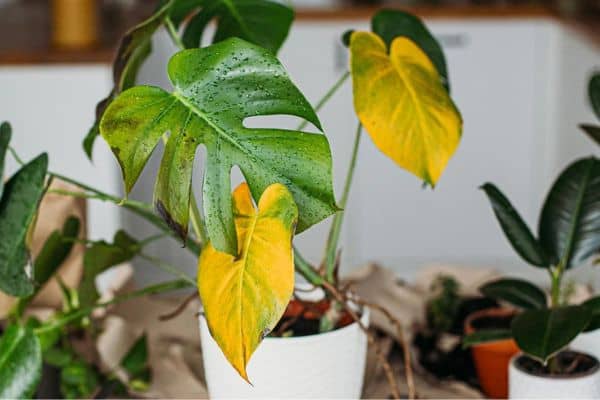Indoor Plants are an excellent way to bring an element of the outdoors into your home. However, they need a certain level of care and attention. One common issue that plant owners may have to deal with is the yellowing of leaves on their indoor plants. This discoloration can be an indication of a variety of problems that can range from simple to complex.
Today, through this article, we will discuss in deep regarding the possible causes behind this issue and provide solutions to restore your plant to its lush green glory.
Understanding the Yellowing of Leaves: A Quick Overview
The yellowing of leaves, also known as “chlorosis” is a common symptom of distress in houseplants. It usually indicates that there is something interfering with the plant’s chlorophyll, which is the pigment responsible for the green color in plants. Yellow leaves can be a sign of various issues such as overwatering, nutrient deficiencies, or even pests and diseases.
Now let us discuss the causes of how the plants turn yellow and the solution to it by following points –
1. Overwatering: A Common Problem
One of the most common reasons behind the yellow leaves is overwatering, which means that the soil of your plant is mostly wet, which can lead to the roots becoming soggy and beginning to rot. This can cause the leaves to turn yellow and eventually fall out.
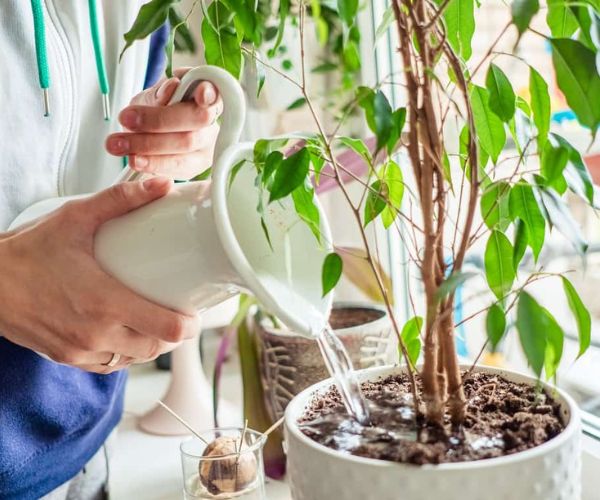
-Identifying Overwatering:
If you are overwatering your plant, the leaves will likely develop a mushy or soft texture and many appear pale. To check for overwatering, stick your finger deep into the soil, if it feels moist, it might be a good idea to leave it for a few days before checking again.
– The Solution to Overwatering:
If you find that you are overwatering your plant, the best you can do is to adjust your watering schedule. Let the top layer of the soil dry out before watering again, also make sure that your flower pot has a proper hole to prevent water from accumulating at the bottom.
2. Underwatering: Another Major Issue-
While overwatering is a major issue, underwatering can also lead to yellowing leaves. If your plant is not receiving enough water, it will be unable to carry out essential processes, causing stress and leaf discoloration.
-Identifying Underwatering:
If your plant’s leaves are turning yellow and get curled inwards, and the soil is dry to touch it’s likely under-watered.
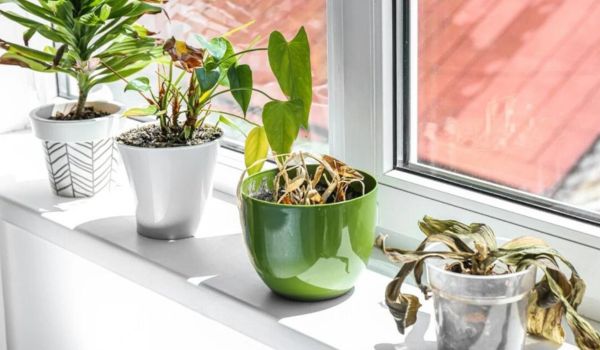
-The Solution to Underwatering;
The solution to underwatering is simple, as you have to water your plant more often. Also, make sure that you are watering it enough so that the soil stays consistently moist but not waterlogged.
3. Nutrient Deficiency-
Another reason why your plant’s leaves may turn yellow is nutrient deficiency. Panys require certain nutrients to develop well, and if they are not getting these nutrients enough, they can show signs of distress like yellowing leaves.
-Identifying the Nutrient Deficiency:
We can identify the nutrient deficiency as the plant shows up as yellowing between lead veins or older leaves. Veins stay green as yellow movies from the leaf center out.
-The Solution to Nutrient Deficiency:
If a nutrient deficiency is the cause of your plants’ yellowing, then fertilize your plants. Use a balanced, water-soluble fertilizer made for houseplants and follow the feeding rate to avoid fertilizer burn.
4. Pests and Diseases–
Yellow leaves can also be caused by a pest or disease. Pests like spider mites, aphids, and mealybugs can damage plant tissue, leading to yellowing leaves. Fungal infections or bacterial diseases can also cause color change.
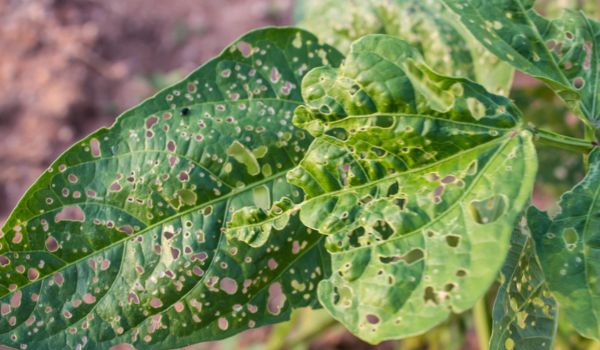
-Identifying Pests and Disease:
Pests and diseases usually leave other signs of an invasion. Are there tiny holes in the leaves? This may indicate that spider mites are chomping on them. Have you spotted a light white wax on your plant? Mealybugs may be the cause.
-The solution to Pests and Disease:
If pests or diseases are the problem, remove the affected plant and treat it with an insecticide or fungicide. Also, increase the humidity level around your houseplants with the humidifier or fill a shallow tray or bow with pebbles and water and put plants on top of it for added moisture.
5. Improper Light: Too Little or Too Much Sunlight–
Both not enough and excessive light can cause stress to your houseplants, leading to yellowing leaves. Each plant type has specific light requirements, and not meeting these needs can lead to leaf discoloration.
-Identifying Improper Light:
A plant that is yellowing from a lack of light will be yellow on the side that is turned away from the light sources.
-The Solution to Improper Light:
If your plan is not receiving enough light consider moving it to a location that receives more sunlight, and if the plant is receiving too much light, move it to a location with less direct light. Also, you can rotate the pot weekly to ensure all slides have access to natural light.
6. Root Problems:
Root-related problems, such as root rot, can delay the plants’ ability to absorb water and nutrients, causing leaves to turn yellow.
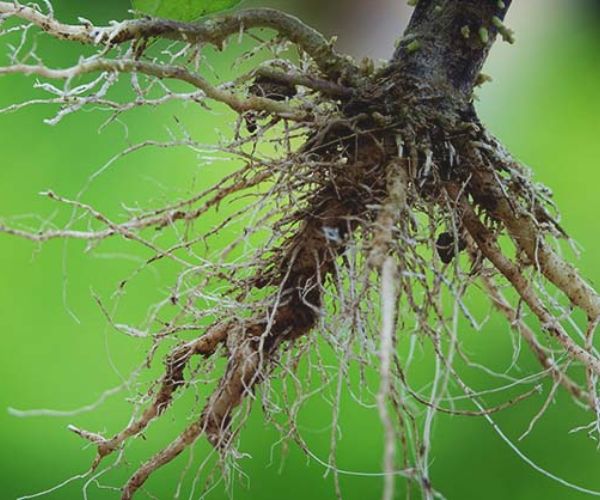
-Identifying Root Problems:
To check for root problems, gently slide your plant out of its pot and inspect the roots. Healthy plant roots are whitish yellow, white dark, rooting roots may smell foul.
-The Solution to Root Problems:
If root rot is the issue, trim away any mushy or discolored roots and repot your plant in fresh, well-draining soil.
7. Cold Air–
Plants are not much into the cold drafts or cold places. If your plants is placed near a drafty window or an overactive air conditioner, the leaves may turn yellow.
-The Solution to Cold Air:
Move your plant to a warmer location or away from cold windows or air conditioning units, also, if the plant is near a cold window, move it further into the room during the winter months.
8. Natural Aging–
Natural aging is a common issue for yellowing leaves, as plants age, lower leaves start turning yellow and fall out. This is a normal part of their growth process, and nothing is to worry about.
Lastly, yellow leaves on indoor plants can be a sign of many issues, but with proper care and attention, your plant can return to its alive green leaves.
FAQs
1. Can the yellow leaf turn green again?
Due to many issues, on different species of plants, a leaf turns yellow, once this has happened, the leaf will remain yellow until it completely falls out, and cannot be turned green again.
2. Are yellow leaves a sign of overwatering in house plants?
Yes, yellow leaves can be a sign of overwatering, as it reduces oxygen in the soil, causing roots to suffocate which results in decreased plant health.
3. What can be the reason for my indoor plants turning yellow?
There might be many reasons for turning your indoor plants yellow overwatering or underwatering, nutrient deficiency, insufficient light, pests and disease, overfertilization, natural aging, and many more.
4. Do the plants grow old?
Yes, plants do grow old, and go through the aging process, as it is a part of their plants’ growth cycle. However, proper care can help the plants live for a longer period of time.
Also, Read 6 Common Indoor Plants Care Mistakes You’re Making, And Tips to Avoid Them
